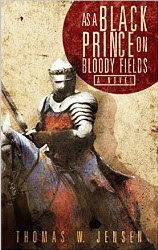This is
episode 31 of my exploration of the life, times and works of Sir Thomas
Malory. Episode 1 can be found here.
There are
but a handful of historical references to Malory in the last decade of his life
and, as I’ve discussed previously, they only pose more, sometimes dramatic
questions about his character and the events that led to them. What do Malory’s sources, how he used them
and Le Morte d’Arthur itself tell us
about him and particularly the last decade of his life?
When I
decided to turn to Malory’s works for answers I assumed, naively, that he had
more or less concatenated and translated a series of French and English
sources, erratically and occasionally adding small emendations, such as details
in the siege of Guinevere in the Tower and that there might be some clues in
those few emendations. The view was
encouraged by Malory himself and his occasional allusions to the “Frenche
boke.” Ralph Norris’ Malory’s Library quickly convinced me
otherwise. Malory, he writes, “expressed
his originality most often in his selection and organization of older stories
and elements rather than by invention.”
So the emendations could well be just a small part of the story and
there could be much more to be learned from Malory’s selection of detail and
story and construction. Subsequently
I’ve come to appreciate that Malory undertook a large and complex project
requiring substantial management and reconciliation of detail as well as
significant structural revision. Indeed,
the more I learn, the less I can rationalize it as the casual pastime of an
incarcerated aristocrat: that just
doesn’t do justice to the passion, imagination and difficult detail work such a
project would have entailed.
What were
Malory’s sources? The three major ones
were the three great Old French prose Arthurian cycles:
- The Vulgate or Lancelot-Graal Cycle of
the 13th century derives from the
romances of Chrétien de Troyes, the French prose Grail Romance Perlesvaus, Robert de Boron’s poem Merlin and elements of the Old
Testament. It consists of five sections:
“The Estoire del Saint Grail” (predominantly concerned with the history of the
Holy Grail and how Joseph of Arimathea brought it to England), “the Estoire de
Merlin” (including the Hugh manuscript of “the Suite du Merlin”) concerned with
Merlin’s history and Arthur’s early life, “the Lancelot Proper,” concerned with
the adventures of Lancelot and other Round Table knights, “the Queste del Saint
Graal” concerned with the quest for the Grail and Galahad’s completion of the
quest, and “the Mort Artu” concerned with Arthur’s death at the hands of
Mordred.
- The cyclic version of the Prose Tristan, written after the
Vulgate is the seminal version of the story of Tristan and Iseult but also
introduces prominent Arthurian characters such as Lamorak, Dinadan and Palamedes. It also reprises the Grail story.
- The Post-Vulgate Cycle or Romance of the Grail derived from the Vulgate consists of four sections, three of which closely parallel the counterparts in the Vulgate and a fourth “the Quest del San Graal,” which has a very different tone from the story in the Vulgate. In general the importance of Lancelot and Guenevere is deprecated and an almost Puritanical ethos is strongly affirmed.
Then there
are the many minor sources, so far scholars have identified 24, here are some
of the more important and notable ones:
- Alliterative Morte Arthure.
- John Hardyng’s rhyming Chronicle of England.
- Chrétien de Troyes Le Chevalier au Lion.
- The Perlesvaus, one of the sources for the Vulgate mentioned above.
- Chaucer’s The Canterbury Tales.
- The poems of John Lydgate.
So, in some
cases, Malory was reconciling and making use of both a source and its sources.
A
particularly telling aspect of his work is the number of minor, previously anonymous
characters whom Malory takes the trouble to name and whose reconciled roles
stretch across the narratives of multiple sources. Some derived from the sources whilst others
were entirely original. Malory occasionally
makes errors with his vast cast but not often, which argues remarkable time
spent cataloging and managing them.
For this
reason I find it harder and harder to concur with the supposition by some of
the most prominent Malory scholars that Le Morte d’Arthur was a work composed
in the final few years of his life. It
is simply too big and the changes he made were too large and detailed. I find I’m in good company with this opinion
as it’s shared by Christina Hardyment, Malory’s most recent biographer who
quotes T. H. White on Le Morte d’Arthur’s structure and literary immediacy:
He “…was
thrilled and astonished to find that (a) the thing was a perfect tragedy; with
a beginning, a middle and an end implicit in the beginning and (b) the
characters were real people with recognizable reactions which could be
forecast. Mordred was hateful; Kay a
decent chap with an inferiority complex; Gawaine that rarest of literary
productions, a swine with a streak of solid decency. He was a sterling fellow
to his own clan. Arthur, Lancelot, and even Galahad were really glorious
people, not pre-Raphaelite prigs.”
(I find it
difficult to think of the pre-Raphaelites or their representation of Arthurian
characters as prigs, but that’s a minor point.)
So, for the
sequel I’ll be presuming that during the that final, presumably tempestuous
decade, Malory was at work on Le Morte d’Arthur. In the next few posts I’ll be following and
commenting on Norris’s analysis of Malory sources for each of Malory’s eight
tales, possibly with some additional biographical deductions.




